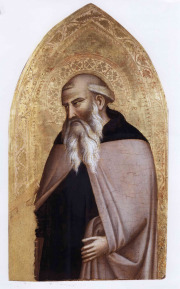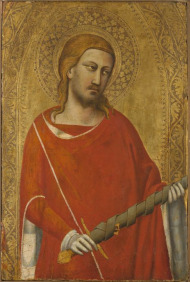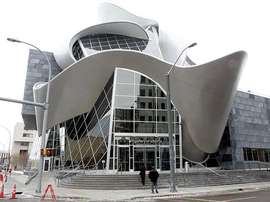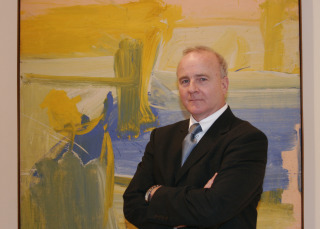 The long-separated Saint Julian (below) and Saint Anthony Abbot (right) belong together, and right now they are living just a couple blocks apart.
The long-separated Saint Julian (below) and Saint Anthony Abbot (right) belong together, and right now they are living just a couple blocks apart.
The two works are by Taddeo Gaddi, a student — the best? — of Giotto. Gaddi (1300-1366) painted the gold ground paintings (tempera on wood) in the 1340s, during his mature period — but they took diverse paths. Saint Julian, holding a sword, hangs in Gallery 3 of the Metropolitan Museum‘s European paintings galleries. Saint Anthony Abbot, staring soulfully, currently resides at Moretti Fine Art, on East 80th Street, just off Fifth Avenue. Moreover, it appears they are both part of an altarpiece in Italy, which will be revealed below.
 Saint Anthony Abbot, Moretti says, had “long escaped the attention of art historians” and when it surfaced in Berlin in 1928, at the Lepke sale, it was labelled “Florentine school, 14th Century.” Only in the 1980s did it gain the Gaddi attribution. That’s about when experts first noticed that Saint Anthony Abbot has comparable measurements, similar punch-work and the same design as Gaddi’s Saint Julian.
Saint Anthony Abbot, Moretti says, had “long escaped the attention of art historians” and when it surfaced in Berlin in 1928, at the Lepke sale, it was labelled “Florentine school, 14th Century.” Only in the 1980s did it gain the Gaddi attribution. That’s about when experts first noticed that Saint Anthony Abbot has comparable measurements, similar punch-work and the same design as Gaddi’s Saint Julian.
Saint Julian, which remained in Italy until at least 1949, found its way into the Heineman collection here and was bequeathed to the Met in 1996 by Lore Heinemann, in memory of her husband, Dr. Rudolf J. Heinemann (and accessioned in 1997). The Met describes the “well-preserved” work as “a cut-down lateral work from an altarpiece.”
Saint Anthony Abbot, meanwhile, has been in Europe. It’s for sale now for $1.5 million, and has attracted some serious interest. One potential buyer was allowed to take it home for a trial.
But wouldn’t it be great if….someone bought it for the Met?
The story wouldn’t end there, though, for Moretti believes that the two panels belong to this altarpiece:
[Read more…] about Time For A Reunion Of Two 14th Century Works? If Only…


 The show is hosted by Michael Rush (right), who was director of the
The show is hosted by Michael Rush (right), who was director of the